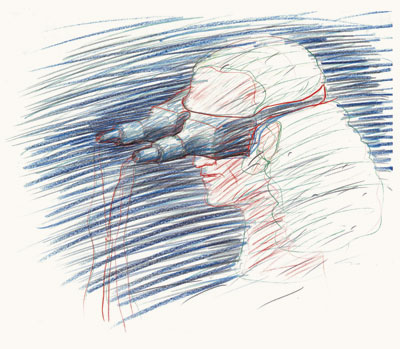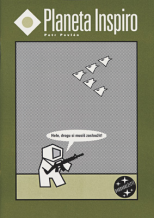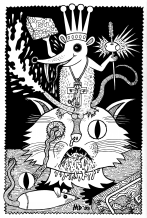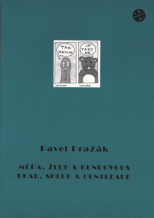| Umělec magazine 2007/4 >> DON’T BELIEVE EVERYTHING YOU HEAR | List of all editions. | ||||||||||||
|
|||||||||||||
DON’T BELIEVE EVERYTHING YOU HEARUmělec magazine 2007/401.04.2007 Lenka Dolanová | seeing | en cs de es |
|||||||||||||
|
In making art I’ve come to the point where all the images that I create exist only in my mind.
Alfons Schilling lives in a spacious flat not far from Vienna’s Westbahnhof train station. I went to visit him in January 2007 in order to find out more about his experimental work with Woody Vasulka. The two men shared a studio together in New York for a short period during the 1960s. For both men, that was a time of social games and the mutual influence of turning points in both their careers. They protested against limitations on painting and cinematography, and they found their own way of seeing. It was at that time that Schilling began to build his first machine. In September I travelled to see Schilling’s exhibit in the Museum of Applied Art. It was called Sehmaschinen 007. At that time we talked again, but this time I wanted to find out more about his own work. The six-hour visit, although at times straining, seemed to fly by: almost to the extent that someone was playing with time. Right from the start Alfons began to explain to me his doubts about methods for structuring facts. “I found out that the world is not as it seems,” he said. “Who says that a day must have twenty-four hours?” He noted that his watch is set up so that it displays ten hours instead of twelve. Later he used a reproduction of Giorgione’s work “Fiesta Campestre” to demonstrate how people don’t know how to look at paintings. “Did you ever look at them?” he asked, pointing out the illogical portrayal of the hands and feet. “It’s all wrong. That’s what happens when you look at things.” In the large central room in his flat, leaning against a wall with a series of photographs of people he had been surrounded by during his time in New York: the postman, a garbage man, a green grocer and his wife, the next-door neighbor on the left, Bob, and the other female neighbor from the flat on the right, and Schilling’s blond girlfriend. Explanations of the theoretical aspects of these works intermingled loosely with life stories that often led back to these people. Schilling's “seeing machines”—Sehgeräte and Sehmaschinen—can be viewed as a type of protest against the accidental nature of sight. One gets vertigo from the fact that our view of the world is only one of many possibilities: a view that is biologically given. Our senses could have developed otherwise. “Sight is accidental; because of all the wave-lengths we use only short distances between 400 and 700 nanometers. We can see neither infra-red nor radio waves. Some animals see a few other waves. With insects, for example, it is interesting that they also see color, whereas cows do not.” His machines raise the question: What would it be like to have different senses? What would we see? And how would we think and feel? Sight is characterized by chance, but our personal destinies are as well. And as Alfons has emphasized many times, it is necessary to be in the right place at the right time. The right place for Alfons Schilling was at first Vienna, where he arrived in 1956 from his home country, Switzerland. He had worked there as a banker (He was born in Basel in 1934). He began studies at the artistic-industrial school; first working in the graphic and then the painters studio. At that time he kept company with Günter Brus, Otto Muehl, and Adolf Frohner: representatives of the Viennese Actionist movement. He shared with these men the desire to overcome painting on canvas by using destructive processes. Later, in Paris, this effort changed into rotating paintings that combined active painting and kinetic sculpture. Hand-movement or motorized circular paintings were covered by gesticular brush strokes. Adding machines to the process meant the end of painting: “I no longer knew what to paint, because a machine could do it for me. I entered a crisis phase. I didn’t know why I should return to Vienna, so I decided to go spend a couple of weeks in New York. I ended up staying 24 years. That was the beginning.” At the start of his New York years, 1962-67, Schilling helped other artists paint and fix up their studios. He also worked on a documentary film about the event entitled Nine Evenings: Theatre and Engineering, a famous series of performances combining avant-garde artists from the theatres and dance with new technologies from engineers at Bell Laboratories in Murray Hill. The event took place in New York in 1966. It was at this time that he met scientist, Don White. Influenced by White, he began as early as 1967 to study the principles of holography at Bell Laboratories. The work of Béla Julesz, a neurologist and experimental psychologist of Hungarian origin who studied mainly depth perception and image recognition as part of visual systems, inspired Schilling to create auto-stereograms. One of Schilling’s first machines was the Spider, which allowed the user to take a series of photos of the same object: a type of continuous 3-D photography. One photo that he took with the Spider machine was a portrait of his neighbor, Bob. “I had the impression that it did not work very well. So I stopped taking pictures,” Schilling explained. Indeed, the human face in the pictures often looks artificial (plastic-like) and most of all the arm extended forward create the impression of entering into the space. Bob was the person that introduced Schilling to stereo photography and sold him his first machine. Schilling used it to take pictures of the Chicago protests against the war in Vietnam. “I had always wanted to do 3-D paintings or pictures. But that all began in 1968,” he said. He wanted to create 3-D images that could be viewed without the help of special glasses. He began to experiment with a lenticular-raster system (Lippman-Linsen-Raster), created by a transparent plastic material whose upper surface consisted of half-cylindrical lenses. Chicago lenticular photography contains several independent 3-D images, each in its own photo optic. They are visible only when the viewer looks at them from a specific angle: “You have to stand and look at them from various directions and you will see different images. The ideal distance is roughly one meter in front of the image. So now when you look you can only see one specific image. It‘s a matter of millimeters, and you can see the image perfectly with both eyes. Which one do you see now? The soldiers with the helmets and gas-masks?” ELECTRONIC SPACES Alfons Schilling is convinced that image development is headed for 3-D format and that his own work is a form of protest against the “tyranny of Cyclopic sight,” meaning art for a single eye. The beginnings of stereoscopy studies date back to antiquity. A more recent essay on the subject worth noting is Sergei Eisenstein’s essay “On the Stereo-Cinema” from 1947. In the essay, Eisenstein claims that the impending final synthesis of all genres will culminate in the utopia of “stereo-cinema,” i.e. stereoscopic film. Schilling’s proposal for “binocular stereoscopic videosystems” was created for the Channel 13 experimental laboratory, where Nam June Paik, Ed Emshwiller and Woody Vasulka also worked. It consisted of two small monitors connected to cameras and placed in front of the left and right eye. “So now my camera is my eyes. Whenever I take off my eyes, I am in control: I can look backward, or I can make everyone stand on one foot and hop. Or I could get a long cable and place the camera here. Then I can watch myself walk around the room from this angle. All in stereo, in this space.” The most important aspect is the idea that we can enter into the space that we are watching. The critic, Peter Weibel, located the theoretical formulation of this environment in the 1973 Electronic Spaces manifesto, the first artistic vision for cyberspace. The “Binocular Video Spectacle” was meant to confine the viewer to the virtual, artificial 3-D environment, where he or she could move about freely. As artificial eyes, two video cameras would offer two perspectives of various images, viewed from two mini-monitors placed in front of the eyes, and the brain would process them into constructs. “It didn’t work very well, because the monitors were black & white and not very clear. So the quality of the material was not good. But I had to show somehow that what I had in mind could function.” Much better known than Schilling’s experiments is the work of American computer scientist, Ivan Sutherland, who by 1966 had already created a “head-mounted display” (HMD) for the Bell Helicopter Company. These were glasses with two small binocular displays with zoom lenses for each eye. They allowed for viewing stereo films or for creating virtual environments. Thanks to technology for capturing head movement, it was possible to produce edited computer images in real time. Another well-known experiment is the “Telesphere Mask” by Morton L. Heilig dating back to 1960. This project combined stereoscopy principles with television. This “stereoscopic TV for individual use” consisted of two miniature TV screens placed in a mask worn over the face. The mask provided 3-D images. Contrary to the previous version, “Sensorama” (1957)—a simulator of virtual reality using a movable 3-D image, smells, stereo sound, air movement and seat vibration—this was a machine that allowed the user to move through a space where computer images merged with shots of the actual environment. VISION MACHINES Schilling later discontinued his experiments with electronic space. He moved on to work with creation of non-digital optical transmission devices that would allow the user to enter the area of augmented reality. This is a combination of virtual reality with features of the real world. It is interactive in real time and offers 3-D imaging. The “sight machines” began initially as a means for viewing Schilling’s stereo paintings and photographs that were difficult to view with the naked eye. He later discovered that some of the machines using both prism and mirror systems were also interesting for viewing landscapes. So he began to use them during nature walks. “But it was very dangerous when I was walking outside, because the machine distorts spatial perception and where you might see a hole in the ground, there’s in fact a big rock there. So if you are looking directly into the machine, you risk falling down. I then decided to set up a sensor (feeler) that would touch and map the ground or nearby trees.” These once small machines now changed into vast structures, which also made an impact with their weight. One could move only very slowly with them. However, as Schilling noted, the physical structure of the apparatus is incomplete: they are definitely not the desired end, and have been developed mainly to fulfill practical needs. In this case, the viewer experience is an interesting factor. Certain machines were exhibited at an event at the Austrian Museum of Fine Art (MAK). They were placed on tall pedestals without allowing visitors the possibility of trying them. “Why would it be necessary to touch the machines? I exhibited them for myself,” defended Schilling. “I look through them and use them.” He added that the aim of these experiments is to create a “fully subjective environment” where creation is on the same level as understanding. The aim is to create a situation. The “sight machine” disrupts our own logic and retinal habits. It offers an experience hovering somewhere between “natural” vision and this machine vision. The machine’s inverse optic changes vertical to horizontal, right to left and flips things on their head. What used to be behind us now stands before us. Things that were once far away are now near to us and vice versa. The image is created only when movement in space begins. It exists only as a unique, individualized experience. This is precisely what Schilling wanted to express when he decided not to talk about binocular images but rather about binocular thought. During my first visit, Alfons showed me his 1978 machine called Gazela. It consisted of prisms and mirrors placed in a wooden stand. He placed a box in front of it, which changed into a hole in the floor. At the exhibit, a pile of bricks was placed in front of Gazela. When flipped upside down they looked as if made of plastic. They literally jumped out from the space around them. The machine turns all spatial relationships for objects upside down: front becomes behind, left becomes right, and negative space assumes a plastic character. “It’s like standing on the vanishing point and looking backward in time,” proclaimed Schilling. Just one look through Gazela is sufficient for us to start asking ourselves if it makes sense to believe our own eyes. In 1975 Alfons Schilling introduced his “points in time theory” in which two simultaneous points in time equals space (2 Ts = Sp). Spatial perception is created in the brain by connecting two different points in space, that is, to different points in time. So the eye is not focusing on a spot, but rather a point in time. When I asked that he explain this theory further, he thought for awhile and later he gave me a filtering strip for creating a so-called “Pulfrich” effect for the return trip by train from Vienna to Prague. This effect can be created when light is dimmed and the brain reacts to incoming information more slowly. When we limit the amount of light entering one eye, thanks to this slowness (delay), we can create a perception of depth. This is because a moving object as viewed with limited light appears delayed vis-à-vis the object seen by the other eye. “It is always a question of space. Different times mean different space. It’s the same in the heavens, where each star has a different time: a different distance,” said Shilling. I held the strip in front of my right eye and objects that were of a medium distance appeared to move extremely slowly and also appeared smaller than they actually were. Once I removed the strip, everything magically got faster. The whole trip home I thought, with the strip in front of my eye, about how nice it would be to enter for a moment into the world “behind the Gazela.”
01.04.2007
Recommended articles
|
|||||||||||||
|
04.02.2020 10:17
Letošní 50. ročník Art Basel přilákal celkem 93 000 návštěvníků a sběratelů z 80 zemí světa. 290 prémiových galerií představilo umělecká díla od počátku 20. století až po současnost. Hlavní sektor přehlídky, tradičně v prvním patře výstavního prostoru, představil 232 předních galerií z celého světa nabízející umění nejvyšší kvality. Veletrh ukázal vzestupný trend prodeje prostřednictvím galerií jak soukromým sbírkám, tak i institucím. Kromě hlavního veletrhu stály za návštěvu i ty přidružené: Volta, Liste a Photo Basel, k tomu doprovodné programy a výstavy v místních institucích, které kvalitou daleko přesahují hranice města tj. Kunsthalle Basel, Kunstmuseum, Tinguely muzeum nebo Fondation Beyeler.
|



































 We Are Rising National Gallery For You! Go to Kyjov by Krásná Lípa no.37.
We Are Rising National Gallery For You! Go to Kyjov by Krásná Lípa no.37.
Comments
There are currently no comments.Add new comment